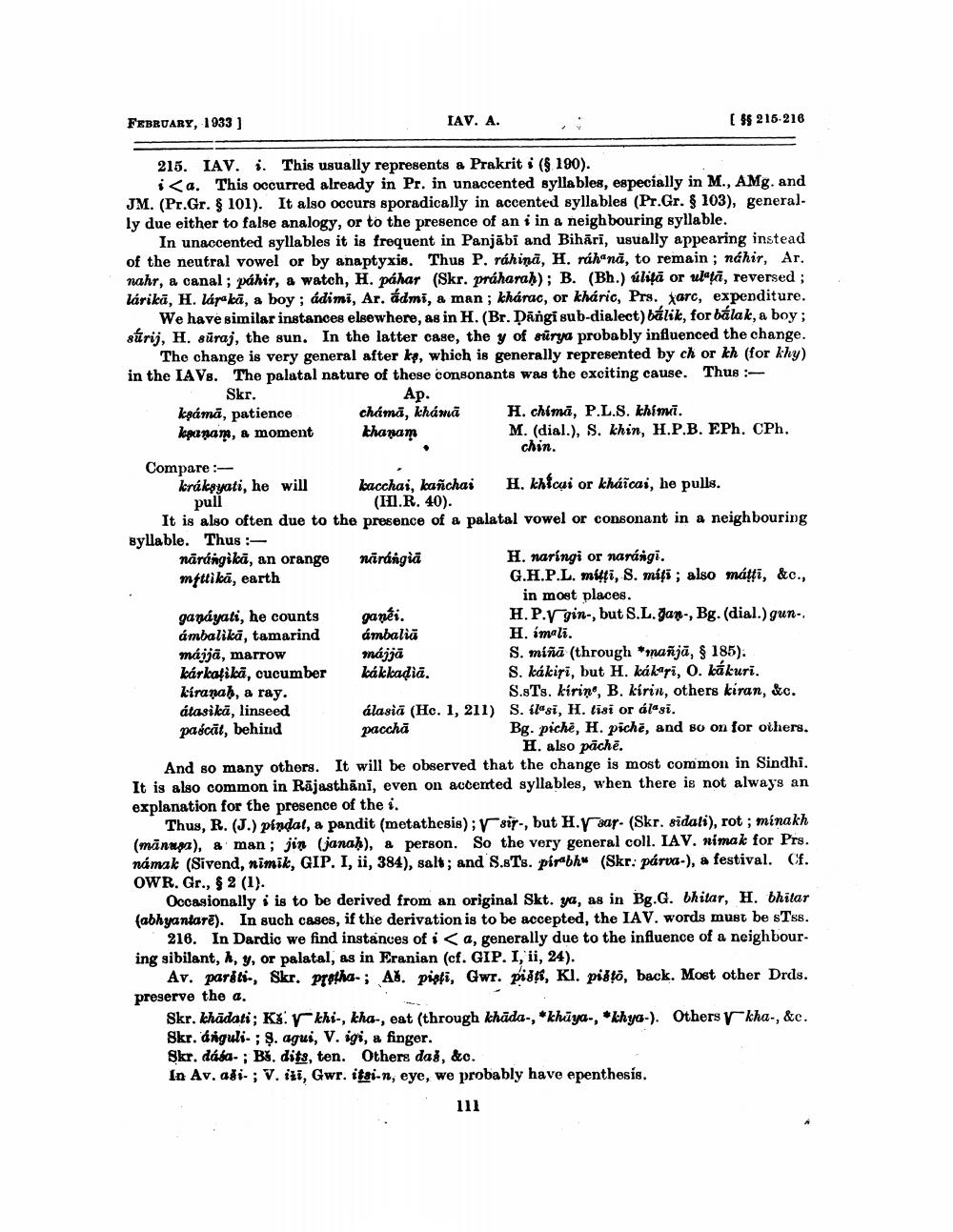________________
FEBRUARY, 1933
IAV. A.
[ $215-216
215. IAV. i. This usually represents a Prakriti (s. 190).
isa. This occurred already in Pr. in unaccented syllables, especially in M., AMg. and JM. (Pr. Gr. 8 101). It also occurs sporadically in accented syllables (Pr. Gr. $ 103), generally due either to false analogy, or to the presence of an i in a neighbouring syllable.
In unaccented syllables it is frequent in Panjābi and Bihāri, usually appearing instead of the neutral vowel or by anaptyxis. Thus P. ráhina, H. náh nă, to remain ; náhir, Ar. nahr, a canal; páhir, a watch, H. pahar (Skr. práharah); B. (Bh.) úlità or ulta, reversed; lárikā, H. láraka, a boy ; ádimi, Ar, ádmi, a man; khárac, or kháric, Prs. arc, expenditure.
We have similar instances elsewhere, as in H. (Br. Dangi sub-dialect) bálik, for bálak, a boy; sūrij, H. ūraj, the sun. In the latter case, the y of sirya probably influenced the change.
The change is very general after kp, which is generally represented by ch or kh (for khy) in the IAV8. The palatal nature of these consonants was the exciting cause. Thus - Skr.
Ap. kpámā, patience chámā, khámā H. chimā, P.L.S. thimci. kpanam, & moment thanam
M. (dial.), S. khin, H.P.B. EPh. CPh.
chin. Compare :
krákoyati, he will bacchai, kañchaiH . khicai or kháīcai, he pulls. pull
(H.R. 40). It is also often due to the presence of a palatal vowel or consonant in a neighbouring syllable. Thus närángikā, an orange näráigia
H. naringi or naráigi. mfttikā, earth
G.H.P.L. mitti, S. mifi ; also mátti, &c.,
in most places. gandyati, he counts ganéi.
H.P. gin-, but S.L.gar-, Bg. (dial.) gun-, ámbalika, tamarind ámbaliū
H. imali. máijā, marrow
májja
S. miña (through manja, $ 185). kárkatilă, cucumber kákkadia. S. kákiri, but H. kákari, O. kákuri. kirana), a ray.
S.sTs. kirine, B. kirin, others kiran, &c. átasikā, linseed
álasia (Hc. 1, 211) S. ilasi, H. lisi or álasi. pascāt, behind
pacchā
Bg. pichë, H. pichi, and so on for others.
H. also pache. And so many others. It will be observed that the change is most common in Sindhi. It is also common in Rajasthāni, even on accented syllables, when there is not always an explanation for the presence of the i.
Thus, R. (J.) pindat, a pandit (metathesis);r sit, but H. V sar. (Skr. sidali), rot ; minakh (mānupa), & man; jin (jana)), & person. So the very general coll. IAV. nimak for Prs. námak (Sivend, nimik, GIP. I, ii, 384), salt; and S.STs. pirabh (Skr. párva-), a festival. Cf. OWR. Gr., § 2 (1).
Occasionally i is to be derived from an original Skt. ya, as in Bg.G. bhitar, H. bhitar (abhyantarē). In such cases, if the derivation is to be accepted, the IAV. words must be sTss.
216. In Dardic we find instances of i <a, generally due to the influence of a neighbour. ing sibilant, , y, or palatal, as in Eranian (cf. GIP. I, ii, 24).
Av. pariti., Skr. Pratha- ; Al. pisti, Gwr. pisk, Kl. piftö, back. Most other Drds. preserve the a.
Skr. khādati; K rkhi-, kha, eat (through khāda., *khuya-, khya-). Others v kha-, &c. Skr. ánguli- ; $. agui, V. igi, a finger. Skr. dása- ; B/. dits, ten. Others daš, &c. In Av. adi- ; V. iti, Gwr. itsi-n, eye, we probably have epenthesis.
111




